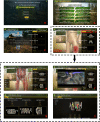Creation and application of war trauma treatment simulation software for first aid on the battlefield based on undeformed high-resolution sectional anatomical image (Chinese Visible Human dataset)
- PMID: 35752811
- PMCID: PMC9233836
- DOI: 10.1186/s12909-022-03566-6
Creation and application of war trauma treatment simulation software for first aid on the battlefield based on undeformed high-resolution sectional anatomical image (Chinese Visible Human dataset)
Abstract
Background: Effective first aid on the battlefield is vital to minimize deaths caused by war trauma and improve combat effectiveness. However, it is difficult for junior medical students, which have relatively poor human anatomy knowledge and first aid experience. Therefore, we aim to create a treatment simulation software for war trauma, and to explore its application for first aid training. METHODS : This study is a quantitative post-positivist study using a survey for data collection. First, high-resolution, thin-sectional anatomical images (Chinese Visible Human (CVH) dataset) were used to reconstruct three-dimensional (3D) wound models. Then, the simulation system and the corresponding interactive 3D-PDF, including 3D models, graphic explanation, and teaching videos, were built, and used for first aid training in army medical college. Finally, the interface, war trauma modules, and training effects were evaluated using a five-point Likert scale questionnaire. All measurements are represented as mean and standard deviations. Moreover, free text comments from questionnaires were collected and aggregated.
Results: The simulation software and interactive 3D-PDF were established. This included pressure hemostasis of the vertex, face, head-shoulder, shoulder-arm, upper forearm, lower limb, foot, and punctures of the cricothyroid membrane, pneumothorax, and marrow cavity. Seventy-eight medical students participated in the training and completed the questionnaire, including 66 junior college students and 12 graduate students. The results indicated that they were highly satisfied with the software (score: 4.64 ± 0.56). The systems were user-friendly (score: 4.40 ± 0.61) and easy to operate (score: 4.49 ± 0.68). The 3D models, knowledge of hemostasis, and puncture were accurate (scores: 4.41 ± 0.67, and 4.53 ± 0.69) and easily adopted (scores: 4.54 ± 0.635, and 4.40 ± 0.648). They provided information about hemostasis and puncture (all scores > 4.40), except for cricothyroid membrane puncture (scores: 4.39 ± 0.61), improved the learning enthusiasm of medical students (score: 4.55 ± 0.549), and increased learning interest (score: 4.54 ± 0.57).
Conclusion: Our software can effectively help medical students master first aid skills including hemostasis, cricothyroid membrane and bone marrow puncture, and its anatomy. This may also be used for soldiers and national first aid training.
Keywords: Chinese Visible Human; First aid; Sectional anatomy; Self and mutual rescue; War trauma.
© 2022. The Author(s).
Conflict of interest statement
The authors have no relevant financial or non-financial interests to disclose.
Figures





Similar articles
-
A Novel Scenario-Based, Mixed-Reality Platform for Training Nontechnical Skills of Battlefield First Aid: Prospective Interventional Study.JMIR Serious Games. 2022 Dec 6;10(4):e40727. doi: 10.2196/40727. JMIR Serious Games. 2022. PMID: 36472903 Free PMC article.
-
Method for Teaching Life-Saving Combat First-Aid Skills With live-actor Patients Using a Wearable Training Apparatus.Mil Med. 2022 May 3;187(5-6):757-763. doi: 10.1093/milmed/usab286. Mil Med. 2022. PMID: 34273161
-
Two-dimensional sectioned images and three-dimensional surface models for learning the anatomy of the female pelvis.Anat Sci Educ. 2013 Sep-Oct;6(5):316-23. doi: 10.1002/ase.1342. Epub 2013 Mar 5. Anat Sci Educ. 2013. PMID: 23463707
-
[Precise application of Traditional Chinese Medicine in minimally-invasive techniques].Zhongguo Gu Shang. 2018 Jun 25;31(6):493-496. doi: 10.3969/j.issn.1003-0034.2018.06.001. Zhongguo Gu Shang. 2018. PMID: 29945400 Chinese.
-
[Advances in the research of application of virtual reality technology in war trauma treatment training].Zhonghua Shao Shang Za Zhi. 2020 Jun 20;36(6):515-518. doi: 10.3760/cma.j.cn501120-20190425-00215. Zhonghua Shao Shang Za Zhi. 2020. PMID: 32594716 Review. Chinese.
Cited by
-
Learning interventions and training methods in health emergencies: A scoping review.PLoS One. 2024 Jul 16;19(7):e0290208. doi: 10.1371/journal.pone.0290208. eCollection 2024. PLoS One. 2024. PMID: 39012917 Free PMC article.
References
MeSH terms
Grants and funding
LinkOut - more resources
Full Text Sources
Medical

